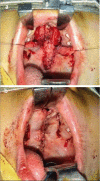Effects of two flap palatoplasty versus furlow palatoplasty with buccal myomucosal flap on maxillary arch dimensions in patients with cleft palate at the primary dentition stage: a cohort study
- PMID: 37530892
- PMCID: PMC10492692
- DOI: 10.1007/s00784-023-05182-0
Effects of two flap palatoplasty versus furlow palatoplasty with buccal myomucosal flap on maxillary arch dimensions in patients with cleft palate at the primary dentition stage: a cohort study
Erratum in
-
Correction to: Effects of two fap palatoplasty versus furlow palatoplasty with buccal myomucosal fap on maxillary arch dimensions in patients with cleft palate at the primary dentition stage: a cohort study.Clin Oral Investig. 2023 Sep;27(9):5615. doi: 10.1007/s00784-023-05200-1. Clin Oral Investig. 2023. PMID: 37572234 Free PMC article. No abstract available.
Abstract
Objective: The objective of this study was to evaluate the effect of two flap palatoplasty (TFP) versus Furlow palatoplasty with buccal myomucosal flap (FPBF) on maxillary arch dimensions in children at the primary dentition stage with cleft palate, in comparison to matching subjects without any craniofacial anomalies.
Material and methods: This study included 28 subjects with an age range of 5-6 years; 10 non-cleft subjects were included in the control group, 9 patients treated with TFP, and 9 patients treated with FPBF. For the included patients, the maxillary models were scanned using a desktop scanner to produce virtual models, and the maxillary dimension measurements were virtually completed. The produced measurements were compared between the 3 groups. Maxillary models of the 28 participants were evaluated.
Results: Statistically insignificant differences were detected between the 3 groups for arch symmetry measurements. Differences were detected in the inter-canine width between the 2 surgical groups and non-cleft group. Both arch length and posterior palatal depth significantly differ while comparing the TFP to the control group, with no differences between FPBF and the non-cleft group.
Conclusion: Furlow palatoplasty with buccal myomucosal flap might be considered a better surgical option than two flap palatoplasty for patients with cleft palate while evaluating maxillary arch dimensions at the primary dentition stage as a surgical outcome.
Clinical relevance: This study gives insight into the surgical technique that has limited effect on the maxillary growth and dental arch dimension. Therefore, it decreases the need for orthodontic treatment and orthognathic surgery.
Trial registration: clinicaltrials.gov ( NCT05405738 ).
Keywords: Cleft palate; Furlow with buccal myomucosal flap palatoplasty; Maxillary dental arch; Two flap palatoplasty.
© 2023. The Author(s).
Conflict of interest statement
It is declared by the authors that they don’t have any competing interests.
Figures



References
-
- Hayashi I, Sakudo M, Takimoto K, Miyazaki T. Craniofacial growth in complete unilateral cleft lip and palate: a Roentgen-cephalometric study. Cleft Palate J. 1976;13(3):215–237. - PubMed
-
- Mars M, Houston WJ. A preliminary study of facial growth and morphology in unoperated male unilateral cleft lip and palate subjects over 13 years of age. Cleft Palate J. 1990;27(1):7–10. - PubMed
Publication types
MeSH terms
Associated data
LinkOut - more resources
Full Text Sources
Medical

